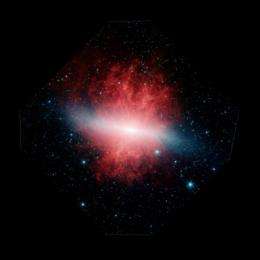Mystery object in Starburst Galaxy M82 possible micro-quasar

(PhysOrg.com) -- Radio astronomers at the University of Manchester’s Jodrell Bank Observatory have discovered a strange new object in a nearby galaxy. The object, which appeared very suddenly in radio wavelengths and shows no signs of going away, does not appear to be like anything that has been seen in the Milky Way. Dr Tom Muxlow will present the discovery at the National Astronomy Meeting in Glasgow.
The galaxy, known as M82, is 10 million light years away and is a stellar production line churning out new stars at a prodigious rate. However, many of these stars die quickly in huge explosions, with a new supernova explosion occurring every 20 to 30 years.
“The new object, which appeared in May 2009, has left us scratching our heads - we’ve never seen anything quite like this before,” said Dr Muxlow. “The object turned on very rapidly within a few days and shows no sign of decaying in brightness over the first few months of its existence. The new young supernova explosions that we were expecting to see in M82 brighten at radio wavelengths over several weeks and then decay over several months, so that explanation seems unlikely.”
The plausibility of a supernova explanation was further undermined when very accurate positional monitoring by the UK network of radio telescopes, MERLIN, tentatively detected a change in position for the object over the first 50 days. This was equivalent to an apparent superluminal motion of over 4 times the speed of light. Such large apparent velocities are not seen in supernova remnants and are usually only found with relativistic jets ejected from accretion disks around massive black hole systems.
The nucleus of M82, like most major galaxies, is expected to contain a super-massive black hole. The new detection lies at a position close to, but several arcseconds from the dynamical centre of M82 - far enough away that it would seem unlikely that this object is associated with the central collapsed core of this galaxy.
The new source could be the first radio detection of an extragalactic ‘micro-quasar’. Examples of such systems within the Milky Way are found as X-ray binaries with relativistic jets ejected from an accretion disk around a collapsed star fuelled with material dragged from a close binary companion. However, this object would be brighter than any Galactic example yet detected, has lasted months longer than any known X-ray binary, and lies at a position in M82 where no variable X-ray source has been yet been detected.
If this object is an extragalactic micro-quasar, it would be the first that has been detected at radio wavelengths. The very high luminosity suggests that it is likely to be associated with a massive black hole system of some type; however this and its longevity imply that this type of object is extremely unusual and has not yet been seen within our Galaxy.
“We have just started processing data from an array of 20 radio telescopes across the Earth were taken for the central nuclear region of M82. These images will allow us to examine the structure of the new radio source in detail. However, processing such huge datasets takes significant amounts of computing effort and painstaking work. Only then will we be able to see if it is some rare form of micro-quasar. Watch this space…!” said Muxlow.
Provided by Royal Astronomical Society



















